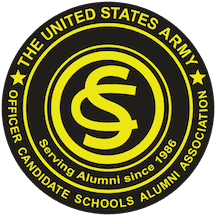February 2020 USAOCSAA Newsletter
President’s Message
Greetings fellow graduates of OCS,
First quarter is always busy for your Executive Committee and the 3rd Battalion, 11th Infantry Regiment S3 as we prepare for the alumni reunion and the Hall of Fame induction ceremony. We changed the agenda allowing us to maximize the weekend and culminate with the Hall of Fame dinner. It all starts with registration on Saturday, May 2 followed by our ice breaker buffet and social. Sunday, May 3 is a full day starting with the alumni brunch and award ceremony followed by tours. Then in the late afternoon, we go to Fort Benning for dedications at the Memorial Walk, an update by the OCS commandant, and the formal dedication ribbon cutting of the OCS Heritage Center at Wigle Hall. All of this is followed by an outdoor barbeque and social with current candidates. Monday, May 4 is the annual membership meeting in the morning, open time in the afternoon, and the Hall of Fame induction ceremony and dinner at the National Infantry Museum. In addition, Hyrum Smith will be honored posthumously as a distinguished member of the Hall of Fame at the OCS Hall of Honor in the National Infantry Museum. You don’t want to miss this year’s reunion. Please register soon.
We executed our sixth expansion in four years on the Memorial Walk. Many monuments were moved to give the walk a nice symmetry. The expansion facilitates growth and should last at least two years before another expansion is required. We have plenty of brick and paver space to meet our historical requirements and room for about 40 24×24 dedication blocks and three spaces set aside for raised monuments.
The OCS Heritage Center is 70% finished and will be ready for the ribbon cutting in May. The six era exhibits have been installed. The featured stories are completed. The corner exhibits (Judge Patterson, OCS locations, Women’s Army Corps, and OCS as the foundation of a successful career) are being fabricated and will be installed soon. The entry wall and the fallen heroes’ exhibits are still being designed but will be fabricated and installed by the reunion. This will be a great tribute to the history of OCS and all of our alumni.
By the time of the reunion, all of our initiatives over the last three years will paid for and we will determine what the sustainment costs will be going forward. We will lay that out at the annual meeting. Large donors have provided about two thirds of our project revenue which includes USAA sponsorship and MOAA graduation awards sponsorship. We hope our efforts over the past three years demonstrate the commitment your Board of Directors has to achieving tangible results. We are going to introduce a new sustainment donor program to ensure we have the resources to meet our goals and objectives and sustain our projects in a first-class manner. What we do ask first is, if you are not already, become a life member of the Association. Second buy a class brick or a HOF or personal paver for installation in the Memorial Walk. The last step is personal. I believe my OCS experience was the foundation of a successful career and a great life. If you agree, I hope you will help us sustain what we have accomplished. Through the Memorial Walk, OCS Heritage Center at Wigle Hall, and our tributes at the veteran memorials on the National Mall in Washington, D.C., we honor our alumni who were killed in action, our Medal of Honor recipients, our members of the Hall of Fame, our classmates, fellow graduates, and cadre. Within your capability, we ask you to help us sustain our recent accomplishments and future initiatives.
Hope to see you at the reunion. Call, write or email anytime.
Standards no compromise. Semper Fidelis. Follow Me.
Frank L. Harman III
Colonel (USA Retired)
President/CEO, USAOCSAA

Commander’s Circle
Greetings from Fort Benning!
Since the fall newsletter, many significant changes have occurred at OCS. First, on January 26 we said farewell to Command Sgt. Maj. Steve Carney who served OCS with distinction for over two years. We appreciate all he did and wish him the best as he transitions out of uniform and into civilian life. At the same time, we welcomed Command Sgt. Maj. Steve Gibbs, who came to us after serving as the operations sergeant major in 1st Brigade Combat Team, 3rd Infantry Division at Fort Stewart. He is no stranger to Fort Benning, however, having served as a first sergeant in the Infantry Basic Officer Leader Course and earlier as cadre at the Non-Commissioned Officer Academy. He comes to us with a depth and wealth of knowledge on how to develop capable, combat-ready leaders, and has already made a significant impression on the cadre and the officer candidates at OCS. He is exactly the type of no-nonsense leader who we need right now and truly sets the example in all he does. He is impressive to watch and we are lucky to have him. He will make a tremendous impact on the future leaders of our Army.
We have undertaken several initiatives to improve the course. First, we are implementing ways to increase the rigor of OCS. We revamped our field training so that officer candidates get to experience how to operate in austere conditions with some sleep deprivation. Further, we’ve increased the evaluation standards to pass squad situational training exercises so that they have to overcome their own personal discomfort to effectively plan and lead the execution of basic tactics. Second, we have fully implemented the new Army Combat Fitness Test. Each candidate has to take the test twice. The first test occurs during Week 1, and while diagnostic, their score is reflected in the branching order of merit list. To graduate the course, however, they have to pass the ACFT under the Army standard. In addition, we have implemented a four-mile release run at the end of the course, where each candidate is required to run four miles in under 36:00 minutes. Finally, we have reconstructed how we teach troop leading procedures and operations orders. Each candidate must now have a comprehensive understanding of these basic tenets to pass this portion of the course. It is no longer a simple regurgitation of what they were taught in class.
As always, thank you to all the OCS alumni and the Alumni Association for all you do to connect the current OCS candidates to the impressive legacy before them. We also thank retired Col. Frank Harman for his work to improve the Memorial Walk and to ensure the OCS Heritage Center is ready in time for the OCS Hall of Fame induction later this spring. In the meantime, we here at OCS look forward to hosting our distinguished alumni and I personally look forward to meeting more of you during the reunion. I am always touched and moved when I engage our alumni classes. I know these touchpoints help our current officer candidates understand the legacy they are about to enter.
Standards!! No Compromise!!
David T. Holstead
Lieutenant Colonel, Armor
Commanding
Office Phone: 706-545-3507
Email: david.t.holstead.mil@mail.mil

Chaplain’s Corner
The Witness of a Wet Wallet
Sam Houston was a man’s man long before the modern macho trend became fashionable. Like other rough men molded by the early American frontier, he knew how to fight, gamble, drink, curse, and kill. He lived in a violent era when life, as we know it, was cheap.
Those early Texans were not against God. If the women, children, and preachers wanted to believe in the Almighty, that was fine with them. Believers were right handy to have around for burial prayers, weddings, and the like. Real men, however, were usually too busy for religion.
But times change, and men (also women) mellow. After the Texans won their war for independence from Mexico, schools and churches sprang up everywhere! Society settled down and communities began to flourish. As they grew older, those rough and adventurous men began taking more interest in spiritual matters, and so did General Houston.
Houston’s wife, a very devout Baptist, prayed for many years that her beloved Sam would join the church. The Texas hero long claimed to be a believer, but baptism and church membership were not easy disciplines for him to accept.
Finally, came the time when the senior statesman of the new republic surrendered. Vowing to go all the way with God, he met the preacher and congregation at the river for baptism. “General,” the minister said, “I suggest you take off that watch and chain. You’ll ruin them if you get them wet.”
“Thank you, I will,” Houston said as he handed them to a friend.
“And General, perhaps you better hand him your wallet too.”
“No, I believe not, Pastor. I’m afraid it needs baptizing too!” Even before his baptism, Sam Houston understood the concept of stewardship. I am NOT saying that God wants just our soul or just our silver.
God wants all of us!
How appropriate that the man who had held out so long from God should have his billfold baptized. A wet wallet became a witness to Sam Houston’s new dedication unto God.
Now, old Sam can speak to all of us, even today. Consider the reflective words of one man who said, “Every now and then the ole devil whispers to me about my time, my talent, my tithe, and my life. ‘Don’t you realize you can have a lots more fun with that money. Why if you stop and think about it, the church (or even your kids) ain’t gonna miss it! Just think of what you could do with all that extra cash (or time, talent, or even your life).’
But then he said, “I came back to reality. I do it because God asks me to do it! He’s never let me down and I’ve a sneaking suspicion that He’s blessed me as He has because I’ve only given back to him a portion of what He’s already given to me!”
Those are powerful words that came from a man who only had a second-grade education. He was never the chairman of the Elder or Deacon Boards. His only job in the church was as an usher. But he had a greater impact on this Chaplain’s life than all the preachers who ever preached in that church!
You have no need to make excuses about what you can or cannot do in service to God!
The same can be said of your service to the OCS Alumni Association. Do not consider what you cannot do, rather consider what you can!
Remember steam crossing or finding Oswichi Creek on night land nav? Candidates come and go, but there are always those who just keep ‘getting wet.’ There is place of service just for you. Please consider giving of your time, talent, and, yes, your donation to keep the OCS legacy alive for officers yet to ‘cooperate and graduate.’

Chaplain (Colonel, USA Retired) Sam Boone served in the Army for over 38 years as an enlisted Soldier, infantry officer, AH-1G cobra pilot, and chaplain. His final assignment was commandant of the U.S. Army Chaplain Center and School, Fort Jackson, S.C. He is a graduate of OCS Class 2-74.
OCS Bookshelf
Boy on the Bridge: The Story of John Shalikashvili’s American Success
by Andrew Marble, PhD
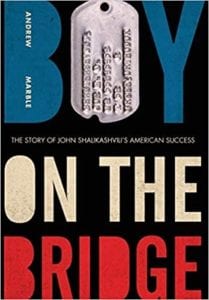
This is a fascinating, easy-to-read, and thorough biography of a distinguished OCS graduate. It delves into the family, background, and psychology of the thirteenth chairman of the U.S. Joint Chiefs of Staff. But this story is anything but a routine biography. “Shali,” as he liked to be called, had much going for him and perhaps more going against him. Yet he rose from being a penniless, stateless, European war refugee to become the highest-ranking officer in the U.S. Army.
Born in Poland, his ancestors were European aristocracy. After surviving war-torn Poland, his family moved to Germany and lived on the charity of family during the rest of World War II. The war ended when he was only eight years old, and he became one of thousands of displaced persons with no citizenship. With help from an American family, the Shalikashvilis relocated to Illinois, where John went to high school and college. He eventually became an American citizen. After college, he was drafted as a private in the U.S. Army and soon applied to attend OCS.
In 1959, the Army was not engaged in combat, so the OCS crucible was even harder than normal. The physical and mental punishments were increased, and many candidates simply dropped out. Shali started Artillery Officer Candidate School and immediately went AWOL. The story Marble tells of how Shali continued and graduated is a story only an officer candidate could appreciate.
Even after he was commissioned, Shali wasn’t sure he wanted to remain in the Army. His first assignment in Alaska influenced his outlook, but his path was still not certain. As a young husband and father, he was forced to deal with the deaths of both his wife and child. He steadily progressed throughout his career. In 1993, he became the first immigrant, first draftee, and, of course, first Officer Candidate School graduate to serve as chairman of the U.S. Joint Chiefs of Staff (1993-1997).
Every officer candidate for nearly eighty years has been shaped by the merciless and sometimes vicious pressure and stress applied by tactical officers in Officer Candidate School. A candidate learns quickly that graduation doesn’t hinge on how many years of service, previous rank attained, family ties, or accomplishments achieved. Most officer candidates will agree that the OCS process took everyone’s psyche to rock bottom and gradually built it up to new heights by instilling leadership, perseverance, tenacity, and self-confidence. As a current TV ad says, it doesn’t matter where you came from. It matters what you’re made of.
Shali led a remarkable American dream story of success through hard work. Andrew Marble weaves an engrossing story and offers a detailed and well researched review of the factors and complexities that helped to shape the life and career of General John Shalikashvili.
Andrew Marble will be one of the keynote speakers at the 2020 reunion.
Mike Harris is a retired major and a graduate of OCS at Fort Benning in May 1975. He now serves on the OCS Alumni Association Board of Directors.
Candidates’ Corner: How OCS Changed Me
OC Colin M. Johnson
Military Intelligence, Active Duty
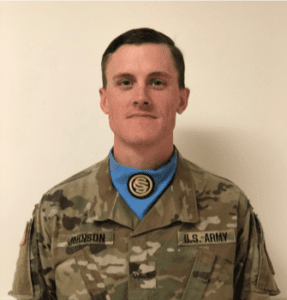
When asked to reflect on what change Officer Candidate School has affected in me, I am inclined to say very little. Rather, it has been the shared experience of completing this course with a wide variety of persons that has changed me and prepared me to be a commissioned officer in the United States Army.
OCS is indeed very much like many other Army schools, churning through the program of instruction, evaluating candidates, and moving on to the next event. Having served in the Army for five years and attended a few Army schools before OCS, I am familiar with the process. I went to OCS with the attitude of just getting through “this thing” that stood between me and a commission. In many ways, the school itself is indeed merely a means to an end. However, if I could attend OCS as one person and test out of all the required knowledge without error, I would accomplish nothing.
OCS has provided me the opportunity to focus not so much on individual soldier tasks and skills, but the opportunity to do it as a part of a group. The group has taught me about how to work with individuals who come from different backgrounds than I do. It has taught me about how different personalities require different types of motivation. I have learned it is not possible to merely share information with my peers; I have to live it out with them. We must do what it is we are all trying to accomplish together, as a collective group, in order to learn together. I am learning how to be direct with some and more discreet or tactful with others when providing feedback. I am learning that not everyone has exactly the same goals or mindset about their career as I do. I am learning that even though there are many different persons with varying levels of competency on this path with me, we are all united in the fact that we serve a bigger mission. I have learned that the success of the Army is not up to how well I know a particular task or how fast I can run a mile. The success of the Army lies in its different parts coming together to function as not merely an organization, but as an organism whose members combine to create one, unified, living entity that is united in “supporting and defending the Constitution of the United States of America.”
OC Jason R. Walker
Ordnance, Active Duty
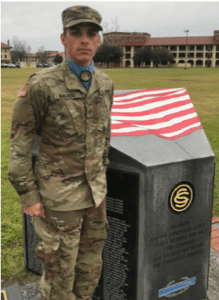
I joined the Army knowing exactly why I wanted to be an officer and serve this country, but I was not yet equipped with the skillset to do so. During my tenure at OCS, I have been given the privilege of interacting with candidates from all around the world. OCS has changed me by allowing me to see and develop many professional interpersonal relationships with future officers from different walks of life. I learned that my personal experiences, background, and beliefs can vary substantially from another candidate, yet we are still able to effectively work together to complete the task at hand. Before OCS, I tended to focus primarily on my world view and solve problems based only on what I knew. Having been subjected to such a diverse group of candidates, I have come to appreciate other peoples’ input and truly value their past experiences.
Being a college option candidate, I have had a limited amount of experience working in a large, professional environment such as the Army. OCS, even more so than Basic Combat Training, made me realize that I will not be able to effectively lead troops if I do not take the time to know exactly who it is that I am leading. Being a leader is much more than simply telling someone what to do. I would never have been able to understand this if it was not for the cadre and their superlative instruction throughout these last nine weeks.
The Army’s definition of leadership states that as officers, we are charged with influencing our Soldiers by providing purpose, direction, and motivation. OCS has allowed me to see exactly how this is successfully executed. Delta Company’s cadre epitomizes effective leadership on a daily basis both in and out of the classroom. They continue to exemplify what it means to influence and inspire subordinates as we work to earn our gold bars and lead America’s Soldiers. OCS has made me a more effective leader due to the interpersonal relationship skills I have developed with my fellow candidates and the outstanding example that Delta Company cadre have demonstrated throughout this cycle.
2LT Ryan M. Howard
Military Intelligence detailed Infantry, Active Duty
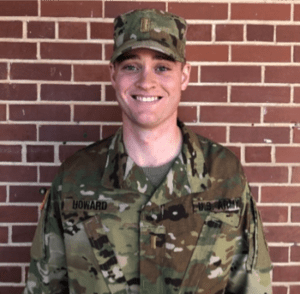
The changes that come from Officer Candidate School are more than just the obvious gain of knowledge and experience. For me, it entailed growing up and standing on my own two feet. This experience developed my drive and my work ethic. It was a process of learning how to manage a life that became imminently more complicated.
Before OCS, I lived at home. I worked a 9-5 desk job where the hardest part of my day was sometimes finding work to do on a team with too many employees for a shrinking workload. Army life was a welcome and necessary change. I look back now and it’s easy to see the change. The idle time I experienced at my old job would drive me insane now. Finding ways to productively fill my time and balance leisure with work is a new and enjoyable skill. Basic Combat Training gave me and other college option candidates the basic tools and structure of Army life, but OCS gave me a challenging environment, the space I needed to grow, and guidance from mentors ensuring I learned from my successes and failures.
OCS gave me confidence in my own drive, ambition, and resiliency. A series of small, simple mistakes that lead to a first time no-go at land nav also drove me to success the second time around. After a mediocre first PT test landed me below the middle of the pack on the order of merit list, I had an uphill challenge ahead of me. However, come branching time I was just outside of the top 20% of the class and was able to secure my top branch choice. By graduation, I had secured a spot on the commandant’s list. It’s hard to imagine myself a year ago setting that type of goal and achieving it. The type of confidence these successes breed is not unique to my own experience, but to OCS as whole.
There are many challenges still ahead for me and my classmates. Many of them sound daunting. They will no doubt be challenging and OCS, as great as it is, did not give me all of the answers. It did, however, give me additional skills to find and figure out those answers. It gave me a structured framework for my life so that I may succeed in the future. It gave me confidence to put one foot in front of the other and confidence that I can absolutely meet the challenges that lie ahead.
OCSAA Member Helps to Provide Military Burials for Unclaimed Remains of Veterans
Judy Christie
Col. Sam Boone, a retired Army chaplain, steps forward on a Friday afternoon at Fort Jackson National Cemetery in South Carolina to give heartfelt remarks for three deceased veterans.
Scores of guests, including members of the Aiken Chapter of the Military Officers Association of America (MOAA), have gathered to pay their respects. An Honor Guard stands at attention. A volunteer plays the somber notes of taps on his trumpet, and a 21-gun salute echoes through the quiet. A bagpipe group performs “Amazing Grace” as those who mourn prepare to depart.
Yet no one present knows these dead.
The crowd pays tribute to honorably discharged veterans whose remains were not claimed or who have no one to honor them upon death. Although exact numbers are not known, estimates put these three veterans among tens of thousands nationwide who die alone and often are homeless. Unclaimed remains are cremated and might be left in storage for years.
Boone, who is president of the Columbia Chapter of MOAA and the OCSAA chaplain, wants to make sure that doesn’t happen. He has found his heart captured by the need to provide these veterans honorable military burials. He and other South Carolina volunteers contact coroners’ offices to learn veterans’ identities, handle required paperwork, and then take custody of remains and prepare military funerals.
He sees this as living up to the Soldier’s Creed never to leave behind a fallen comrade. “A burial with honor fulfills that promise,” Boone says. “It’s the right thing to do.” He helps hold services quarterly, often for the cremated remains of three to five veterans.
Boone is working with retired Col. David B. Lobb, president of MOAA’s South Carolina Council of Chapters, to engage MOAA chapters across the country, starting with talks to MOAA chapters throughout South Carolina.
“MOAA chapters can work with a VA national cemetery in their area,” Boone says, “and assist in identifying remains and doing paperwork required by local and state laws and honoring all who have served our nation.”
Boone, a former AH-1G Cobra pilot, went to divinity school to become a chaplain and commits himself to helping veterans and their families in a variety of ways. He spreads the word about these funerals so community members can attend, and he writes eulogies that include details about the deceased veteran’s military service.
“What makes these so special is how our community – both veterans and those who have never served in the military – turns out for someone most of us never knew,” he says.
The program is done in partnership with other veterans’ groups, including the Missing in America Project, and funeral homes that donate their services. State legislatures must pass a law allowing military organizations to claim these remains, something that is happening across the country.
Lobb praises Boone as a leader in this effort and many others and hopes other MOAA councils will embrace this cause.
“What shocks me is how many unclaimed remains there are,” Lobb says. “This is something people need to know about – and not only in South Carolina. We need to do this. … If you’re a veteran, you’ll never be forgotten.”
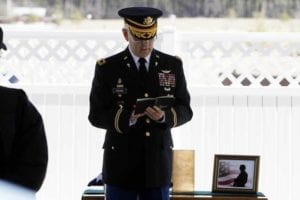
Retired Chaplain (Col) Sam Boone, president of MOAA’s Columbia, S.C., Chapter and the OCSAA chaplain, speaks during funeral services for a veteran whose remains were unclaimed. (Courtesy of WIS-TV)
This article originally appeared on MOAA.org, the Military Officers Association of America website. MOAA is the nation’s largest association of military officers, serving all seven uniformed services.
Memories
Few Know the Real History of the Humvee
James Wright
Forty years ago, I was tasked as the Training and Doctrine Command (TRADOC) System Staff Officer (TRASSO) for infantry branch to develop the required operational capability document for the High Mobility Multipurpose Wheeled Vehicle (HMMWV, called the Humvee). The requirement for a high-mobility wheeled vehicle originated from a message from the commanding general of the 82nd Airborne Division, then Maj. Gen. John Foss, later to be the commander of TRADOC, to the commanding general of TRADOC, Gen. William DePuy. The emphasis was to be placed on the direct combat role and especially the TOW carrier, which was the primary anti-armor weapon system of the 82nd. (Editor’s note, for those interested, “TOW” stands for tube-launched, optically-sighted, wire-guided.) The proponent school was to be the Infantry School, which was a major departure from previous combat developments for wheeled vehicles which was generally the responsibility of the Transportation School. DePuy recognized the sheer quantities for combat support and combat service support would drive the acquisition if not control it. He wanted to ensure the combat requirements did not get watered down. To pay for the combat requirements, we had to reduce the logistical and maintenance burden on the Army. Therefore, the Humvee was designed to replace the ¼-ton Jeep, M274 truck (the “Mule”), ¾-ton truck, and the Gamma Goat.
The search for a solution required an examination of technology. The closest actual prototype to the Humvee requirement was the XR311 Dune Buggy being tested by the Marine Corps at Twentynine Palms. Therefore, it pointed the direction. The initial contractor was Food Machinery Corporation (FMC), San Jose, Calif. They built the first Humvee and supported it through the lengthy and challenging combat developments / materiel developments acquisition process.
Inasmuch as every Army unit forward of the division rear boundary would be equipped with the Humvee, the efforts to gain concurrence from all Army branches was an enormous challenge. This challenge carried over into all aspects of the Humvee acquisition to include training, operational and developmental testing, contracting, manpower and personnel integration, resource allocation, priority drills at TRADOC and HQDA, logistics, tactical employment, and a host of other considerations. The overriding requirement that I was not allowed to violate was the capability to lift the Humvee by a UH-60 Black Hawk helicopter in a Middle East scenario.
DePuy was replaced by Gen. Donn Starry who further validated the hard combat requirement. Starry became the impetus behind the type classification and acquisition decision. He personally subjected the Humvee to his scrutiny which included driving the vehicle over an extreme obstacle course at Fort Monroe. At the end of this scrutiny, he turned to me and said “You get this in the force structure immediately and anyone who gives you any crap let me know. And, oh by the way, do not water down the direct combat specifications.”
Thousands of hours of travel to test sites and other system meetings throughout the United States (Twentynine Palms; Fort Hunter Leggett; San Jose, Calif, home of FMC; Warren, Mich., home of Tank-automotive & Armaments Command; every TRADOC school and center; White Sands Missile Range; and a second life at Fort Benning) finally lead to type classification and initial operational capability.
But that’s not the end of the story!
One of Starry’s first actions after assuming command of TRADOC was to call me into his office for an old-fashioned butt chewing. As I entered his office and saluted, he reached into a cardboard box and extracted a cow chip which he threw at me. He was disappointed that Northrop Corporation’s concept for an Improved TOW Vehicle (ITV) with an articulating head had not won the production contract and thought I had let him down since this had been a promising concept while he was still the commanding general of the Armor School at Fort Knox. It employed a fiber optics bundle that would afford a distinct advantage during Military Operations on Urbanized Terrain (MOUT) by enabling the ITV to shoot around corners without exposing the vehicle. I explained the results of several developmental and operational tests that essentially validated the concept, but it could not withstand the rigorous operational tests using Soldiers and demonstrated some serious reliability, availability, and maintainability issues that proved to require costly fixes. He threw another cow chip at me and ordered me out of his office. I figured I was on borrowed time before I had another cow chip thrown at me related to the development of the HUMVEE. Turns out, in one of his many hobbies and activities, he was a recognized cow chip throwing champion and I was not convinced I would succeed in dodging his future wrath.
The infamous obstacle course at Fort Monroe
I was already familiar with his reputation and had a seat belt and shoulder harness installed for Starry’s own protection. In his previous capacity as the commanding general of the Armor School, he operated a skunkworks project to fabricate new vehicle concepts and technologies. I had a stretch M113 armored personnel carrier with a souped-up RISE engine. He put one of my test drivers in the back, took over the controls, and ran the vehicle across an extreme tank track. Of course, the driver in the back did not have a seat belt and got slammed against the side armor sustaining enough of an injury that we had to take him to the hospital.
By the time he showed up at Fort Monroe he was a four-star general, but he still retained the old spunk. Needless to say, he initially refused to put on the seat belt and shoulder harness so I had to convince him FMC Corporation still owned the vehicle and did not want to be liable for any injury. He finally agreed, but I used the slack in the seat belt to tie him in so he could not hit the quick release as soon as he was out of sight. He ran the Humvee over a 10-15-foot berm along Dog Beach, ran down the beach steadily picking up speed, and eventually went out of sight in an inlet filled with water. I guess his forward speed was enough to propel him though the inlet, jump back over the berm, and into the Mill Point swamp.
He had the power at that point to kill the entire Humvee project but fortunately became an ardent supporter.
James Wright is a retired lieutenant colonel who was commissioned an infantry officer upon graduation from Officer Candidate School Class 5-66, April 14, 1966. Jim was inspired to pursue an Army career related to combat and materiel developments as a consequence of the M-16 rifle fiasco he experienced in Vietnam in 1967 as an infantry platoon leader with the 1st Cavalry Division (Airmobile). Many men died or were wounded as a result of the failure to properly test the rifle and associated ammunition using live (not virtual) Soldiers under operational conditions. This experience underpinned Jim’s motivation and determination during his subsequent assignments and experience as combat, materiel, and training developer.
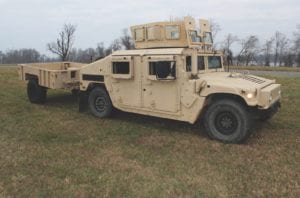
Do you have a short story about your military experience? Send your story to socialmedia@ocsalumni.org and it could be featured in an upcoming edition of the OCSAA newsletter.
History of TRADOC: The United States Army Training and Doctrine Command
Paul Cook
One of the Army’s four major commands, the U.S. Army Training and Doctrine Command (TRADOC), dates from 1973 and a restructuring of Army commands within the continental United States.
Before there was TRADOC, there was the Continental Army Command (CONARC). CONARC performed many of the roles now carried out by both TRADOC and its sister command, U.S. Army Forces Command (FORSCOM). CONARC consisted of the field armies (First Army, Second Army, Third Army, etc.) located within the continental United States. Though charged with a continental defense mission, these organizations were essentially administrative in nature and owned everything that was the Army’s within their geographic boundaries. This included installations and supervising the training of reserve component units. It also meant operating the various training centers and schools for a large force characterized by massive personnel turnover resulting from the draft. Large in terms of Soldiers assigned and diverse in terms of missions assigned, CONARC was unwieldly and the Army sought a better way to orchestrate the command’s myriad missions.
Started under the tenure of Army Chief of Staff Gen. William Westmoreland, and known as STEADFAST, an exhaustive study sought to redefine the Army’s administrative organization and create commands with clearly defined responsibilities to improve the service’s ability to perform its Title 10 USC missions. Headquartered today at Fort Eustis, Va., TRADOC performs four primary functions:
*Recruit and train Soldiers and support unit training
*Develop leaders (both military and civilian)
*Guide the Army through creating doctrine
*Shape the Army by building and integrating formations, capabilities, and materiel
To perform these functions, TRADOC consists of five major subordinate commands and 32 different Army Centers of Excellence (Intelligence, Maneuver, Maneuver Support, Signal, etc.) to train Soldiers and civilians alike. The five subordinate commands are the U.S. Army Center of Military History at Fort Lesley J. McNair, Washington, D.C.; the U.S. Army Combined Arms Center at Fort Leavenworth, Kan.; the U.S. Army Center for Initial Military Training at Fort Eustis, Va.; the U.S. Army Recruiting Command; and the U.S. Army Cadet Command—the home of Army ROTC. Both the Recruiting Command and Cadet Command are located at Fort Knox, Ky.
The Center of Military History’s website is an exceptional resource for individuals exploring the Army’s history. The center has digitized virtually all its major holdings making research a relatively easy task.
The Combined Arms Center is home to the newly chartered Army University, an organization consisting of nine different colleges or schools educating officers, warrant officers, senior non-commissioned officers, and Army civilians. It also includes the Western Hemisphere Institute for Security Cooperation. This unique school makes available intermediate-level (majors and lieutenant colonels) education in Spanish for our Latin American partners. The command also supervises one of the Army’s most unusual units—the U.S. Army Asymmetric Warfare Group (AWG). The AWG is TRADOC’s only operational unit and routinely deploys its members around the world.
The Center for Initial Military Training bears responsibility for the Army’s initial entry training programs at Fort Benning, Ga.; Fort Jackson, S.C.; and Fort Leonard Wood, Mo. It is also responsible for establishing baseline standards of proficiency in critical skills trained in the basic officer leader courses at each of the various centers. The center is also the proponent for one of the most publicized changes taking place within the Army—replacing the Army Physical Fitness Test with the Army Combat Fitness Test. The new test better reflects the requirements of the battlefield and incorporates lessons learned about the physical demands placed on Soldiers since 9-11.
The U.S. Army Recruiting Command (USAREC) supervises the Army’s six recruiting brigades that recruit both in the United States and overseas. Five of these brigades recruit enlisted Soldiers and officer candidates. The Medical Recruiting Brigade focuses on recruiting medical professionals and chaplains. USAREC also is home to the Army Marksmanship Unit, the Golden Knights (the Army’s parachute demonstration team), and the Army eSports and Warrior Fitness teams.
The U.S. Army Cadet Command is responsible for the Reserve Officer Training Corps and Junior Reserve Officer Training Corps programs. Cadet Command commissions the majority of the Army’s officers in any given year and operates programs in all 50 states, the District of Columbia, and the territories of Guam, Puerto Rico, and the U.S. Virgin Islands. These programs operate through a combination of on-campus programs and cross-enrollment agreements whereby cadets attending a university lacking an ROTC program participate at a university hosting one. Unlike the ROTC program, Army Junior ROTC is a citizenship program focusing on developing character and leadership skills. Dating to 1916, this program resides in over 1,700 high schools across the country and in overseas U.S. military communities.
Subordinate to TRADOC are two of the Army’s most important training centers: the National Training Center at Fort Irwin, Calif. and the Joint Readiness Training Center at Fort Polk, La. These training centers provide high-fidelity training for battalions and brigades. Two key elements of both training centers are a dedicated opposing force (OPFOR), and a cadre of observer-controllers (OCs). The OPFOR replicates a range of threats and provides a non-cooperative enemy for units to train against. This provides training opportunities that go far beyond narrow training lanes by allowing the full integration of all the staff and functional elements of a combined arms task force or brigade combat team. The OCs embed with units undergoing training and provide real time assessments in the form of After-Action Reviews (AARs) throughout a training rotation. The AAR focuses on what should have happened, what happened, why it happened, and includes recommendations in procedures and tactics to facilitate unit growth.
The 2019 creation of U.S. Army Futures Command brought about changes to TRADOC as some developmental functions migrated to the new organization. Despite this, TRADOC remains as the Army’s incubator and university. While assignment to TRADOC will likely never carry the same prestige as assignment to a combat division, the reality is a division’s combat potential is a direct reflection of TRADOC’s efforts in providing the Soldiers, the materiel, and the training required to build effective combat organizations.
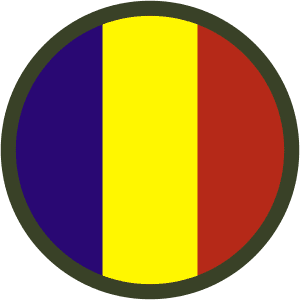
Paul Cook is a retired colonel and doctoral student in military history at Temple University.
2020 Hall of Fame Inductees
The OCS Hall of Fame Induction Board convened on December 18, 2019. After much deliberation, the board concluded with 53 new members being elected into the OCS Hall of Fame. The board of seven voting members consisted of five active officers and two retired officers.
Nominees may qualify for election by meeting various eligibility criteria and failing into one of five categories. The five categories are:
Superior Valorous Combat Leadership: includes recipients of the Medal of Honor or the Distinguished Service Cross.
Superior Meritorious Service: includes successfully completing a battalion/ brigade command (or the equivalent) from which their service was recognized as superior and meritorious and they were awarded the Legion of Merit or Defense Superior Service Medal and have served in the rank of colonel or above.
Distinguished Public Service: includes holding the position of member of Congress, governors of a state, cabinet secretaries, U.S. ambassadors, mayors of large cities, and federal judges.
Superior Public Service: includes high-ranking civil servants (GS-15/SES), high-ranking state officials, members of state legislatures, mayors, sheriffs, police chiefs, city managers, and CEOs of philanthropies.
Lifelong Service: includes individuals who have a life of service to the nation and to their community which starts with valorous combat leadership and/or meritorious service and then continued with outstanding public service through volunteerism, especially in support of military service members, veterans, and their families.
Congratulations to the 53 newly elected members of 2020!
LTG Roger Schultz
BG Robert Cocroft
BG Glenn Goddard
BG Gerald Griffin
BG Jeth Rey
COL Shelley Balderson
COL Stephanie Batten
COL William Bayha
COL Phillip Bender
COL Lucious Delk
COL William Dickens
COL Kenneth Harding
COL Ernest Hepler
COL Richard Hoerner
COL Ronald Hyatte
COL Ronny Johnson
COL Christopher Kennedy
COL Carolyn Kleiner
COL George Lind
COL Robert Moore
COL Craig Smith
COL Ciro Stefano
COL John Suggs, Jr.
COL Jerrold Scharninghausen
COL Thomas Staadt
COL Richard Surowiec
COL David Tool
COL Robert Ulin
COL Donald Venn II
COL Edward Vogelsang
COL Daniel White
LTC James Pasqualini
LTC Neal Whetsel
LTC Richard Wood
MAJ John Brown
MAJ Ronald Markiewicz
MAJ Arthur Minnefield
MAJ Ralph Northrop
CPT Norman Baldwin
CPT Stanley Blunt
CPT Thomas Burke
CPT Joseph Donner
CPT Ronald Highland
CPT Mark Holbrook
CPT Walter Lee
CPT Robert Walker
1LT Blake Clark
1LT William Cody
1LT Loren Hagen
1LT Barry Mawn
1LT Raymond Parker
1LT Nicholas Snider
1LT Joseph Snyder
The OCS Hall of Fame induction ceremony will take place on Monday, May 4 at 4 p.m. at the Nation Infantry Museum.
